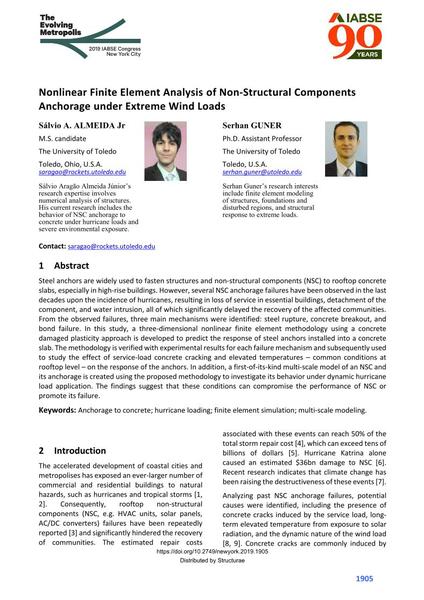Nonlinear Finite Element Analysis of Non-Structural Components Anchorage under Extreme Wind Loads

|
|
|||||||||||
Détails bibliographiques
| Auteur(s): |
Sálvio A. ALMEIDA Jr
(The University of Toledo)
Serhan Guner (The University of Toledo) |
||||
|---|---|---|---|---|---|
| Médium: | papier de conférence | ||||
| Langue(s): | anglais | ||||
| Conférence: | IABSE Congress: The Evolving Metropolis, New York, NY, USA, 4-6 September 2019 | ||||
| Publié dans: | The Evolving Metropolis | ||||
|
|||||
| Page(s): | 1905-1910 | ||||
| Nombre total de pages (du PDF): | 6 | ||||
| DOI: | 10.2749/newyork.2019.1905 | ||||
| Abstrait: |
Steel anchors are widely used to fasten structures and non-structural components (NSC) to rooftop concrete slabs, especially in high-rise buildings. However, several NSC anchorage failures have been observed in the last decades upon the incidence of hurricanes, resulting in loss of service in essential buildings, detachment of the component, and water intrusion, all of which significantly delayed the recovery of the affected communities. From the observed failures, three main mechanisms were identified: steel rupture, concrete breakout, and bond failure. In this study, a three-dimensional nonlinear finite element methodology using a concrete damaged plasticity approach is developed to predict the response of steel anchors installed into a concrete slab. The methodology is verified with experimental results for each failure mechanism and subsequently used to study the effect of service-load concrete cracking and elevated temperatures – common conditions at rooftop level – on the response of the anchors. In addition, a first-of-its-kind multi-scale model of an NSC and its anchorage is created using the proposed methodology to investigate its behavior under dynamic hurricane load application. The findings suggest that these conditions can compromise the performance of NSC or promote its failure. |
||||
